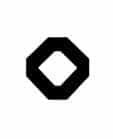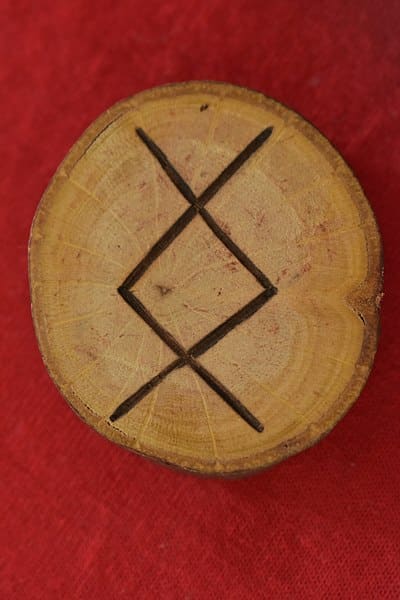In the ancient world, symbols held a profound significance. One such symbol, a rune from the Elder Futhark system, has captured the fascination of scholars and enthusiasts alike. This rune, known as Ingwaz, is a symbol of both potential and growth as well as the cyclical nature of existence. It’s a rune that whispers of the old ways, of the Norse people who once carved these symbols into stone, bone, and wood, seeking to understand and influence the world around them.
Ingwaz Background and Description
The Elder Futhark, is the oldest form of the runic alphabets. It was used by the Germanic tribes for the northwestern and Migration period dialects. Its inscriptions date back to the 2nd to 8th centuries, with some even suggesting an origin as early as the 1st century AD. The Ingwaz rune, also known as Ing, is the 22nd rune in this system, nestled between Laguz and Dagaz.
The name Ingwaz is derived from the Proto-Germanic *Ingwaz. It is believed to have been another name for the god Freyr (Ing), and is associated with fertility and prosperity. Freyr, also known as Yngvi or Ing, was considered the progenitor of the Ingaevones, a Germanic group that included the tribes of the Angles, Saxons, and Jutes. These tribes, as you may know, later migrated to the British Isles, carrying with them their language, culture, and the worship of Ing.
Graphical Representation


The Ingwaz rune is recognized in two different shapes, either as two X’s on top of each other, or as a simple diamond shape, basically the core of the two X’s. This simple yet powerful design is believed to symbolize a seed or an egg, a potent symbol of potential and new beginnings. The rune’s design is straightforward, making it easy to draw, but its simplicity belies the depth of its meaning.
Historically, the design of the Ingwaz rune has remained relatively consistent. There was likley minor variations depending on the material it was inscribed on or the personal style of the scribe. This consistency suggests that the symbolic meaning of Ingwaz was both well understood, and respected by the ancient Germanic peoples.
Phonetic Value
In the Proto-Germanic language, the Ingwaz rune represented the sound “ŋ”. It is similar to the “ng” sound in English words like “long” or “sing”. This sound is known as a velar nasal, produced by closing off the back of the mouth and allowing the air to escape through the nose. Over time, as the Germanic languages evolved and diversified, the phonetic value of the Ingwaz rune may have changed in different regions and dialects.
Symbolic Meaning of the Ingwaz Rune
The Ingwaz rune is a symbol of potential, growth, and the cyclical nature of existence. Its name, derived from the divine entity Ing (Freyr), carries connotations of fertility and prosperity, reflecting the importance of these concepts in ancient Germanic culture. The seed or egg shape of the rune further emphasizes this symbolism, representing the promise of new life and the potential for growth.
In the context of Norse mythology, the Ingwaz rune is, as I mentioned, associated with the god Freyr, the brother of the goddess Freyja. Freyr, known as the “Lord” in Old Norse, was a deity associated with prosperity and sunshine as well as fertility. This is making him a fitting figure for the symbolism of the Ingwaz rune. You can learn more about Freyr here.
The Aett and its Symbolism
The Elder Futhark is divided into three groups known as aettir. Each aett is associated with a particular god or goddess and carries a distinct thematic symbolism. The Ingwaz rune belongs to the third aett, which is associated with the god Tyr.
The third aett, also known as Tyr’s aett, carries themes of balance, justice, and order. These themes reflect Tyr’s role as a divine lawmaker and his legendary sacrifice of his hand to the wolf Fenrir. The Ingwaz rune, with its symbolism of potential and growth, contributes to these themes. Moreover it reminds us of the cyclical nature of existence and the potential for growth and change within established order.
Elder Futhark Quiz
Do you want to test your knowledge of Elder Futhark runes? Then this quiz is perfect for you!
Don’t forget to play our other games as well!
Ingwaz Used in Divination and Magic

via Wikimedia Commons
Truth be told I don’t personally subscribe to the belief in divination or magic. However I find the historical and cultural practices surrounding these beliefs to be fascinating. The Ingwaz rune, like other runes in the Elder Futhark, was likely used in divination and magical practices.
In divination, the Ingwaz rune may be interpreted as a sign of potential, growth, or a period of gestation. It could suggest that the querent is in a phase of preparation or development. Moreover, there might be a promise of future growth and achievement. In a magical context, the Ingwaz rune could be used in spells intended to foster growth, prosperity, or fertility.
Ingwaz in the Younger Futhark – The Lost Fertility
The Elder Futhark transitioned into the Younger Futhark, also known as Norse runes, around the 7th and 8th centuries. That change saw Ingwaz, representing fertility or the god Ing, vanished. Its disappearance signifies a transformation in the expression and understanding of fertility, growth, and the divine.
Frequently Asked Questions
The Ingwaz rune symbolizes potential and growth as well as the cyclical nature of existence. It is associated with the divine entity Ing, a figure of fertility and prosperity in Germanic paganism.
In divination, the Ingwaz rune may be interpreted as a sign of potential, growth, or a period of gestation. Moreover it suggests a phase of preparation or development, with the promise of future growth and achievement.
The Ingwaz rune may be associated with the god Freyr. The god of prosperity and sunshine as well as fertility in Norse mythology. Furthermore, the rune belongs to the third aett of the Elder Futhark, which is associated with the god Tyr.
